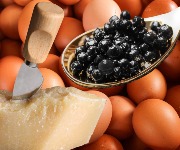Stir-up Sunday and Christmas pudding tips

Do you know what Stir-up Sunday is? Here are some clues: it involves pudding, a magic wish, Jesus' disciples and a silver coin.
Stir it in turn, from East to West
It all started in Medieval England, around the 1540s, when the Roman Catholic Church decreed that a “pudding should be made on the 25th Sunday after Trinity” – roughly one month before Christmas Day.
The pudding, which always contained some sort of fruit, had to be "prepared with 13 ingredients to represent Christ and the 12 apostles" and during the baking process "every family member [must] stir it in turn from east to west to honour the Magi (the three wise men) and their supposed journey in that direction". Hence the name Stir-up Sunday, still used today.
Indeed, the prayer for the 25th Sunday after Trinity in the Book of Common Prayer, as it was used in the 16th and 17th century, reads:
The pudding king
 The pudding recipe became sweeter as the years went by. By the 17th century plum flesh was a popular ingredient for it, and in 1714 King George I (pictured left), 'The Pudding King', requested plum pudding as one of many desserts at his first royal Christmas feast. But despite his fancies, plum pudding was actually more routinely eaten at Harvest Festival time. It wasn’t until the 1830s that the pud was made exclusively sweet (previously it could contain both meat and vegetables, as well as fruit) and exclusively Christmassy, topped with holly and set alight at the table. Some believe that plum puddings were first set on fire to represent Christ’s passion, and the holly sprig was a reminder of his crown of thorns.
The pudding recipe became sweeter as the years went by. By the 17th century plum flesh was a popular ingredient for it, and in 1714 King George I (pictured left), 'The Pudding King', requested plum pudding as one of many desserts at his first royal Christmas feast. But despite his fancies, plum pudding was actually more routinely eaten at Harvest Festival time. It wasn’t until the 1830s that the pud was made exclusively sweet (previously it could contain both meat and vegetables, as well as fruit) and exclusively Christmassy, topped with holly and set alight at the table. Some believe that plum puddings were first set on fire to represent Christ’s passion, and the holly sprig was a reminder of his crown of thorns.
Eliza Acton, an English poet and cook who published one of the country’s first ever cookbooks, was probably the first to call it ‘Christmas pudding’ in her Modern Cookery for Private Families, published in 1845. She titles it 'The Author's Christmas Pudding', and calls for flour, breadcrumbs, suet, raisins, currants, minced apples, sugar, candied orange rind, nutmeg mixed with mace, salt, brandy and eggs. Best eaten with German wine or a punch sauce, apparently!
Christmas pudding today
 Gone are the Roman Catholic plum pudding traditions, today it’s more of a superstitious exercise. We’ve swopped the significance of the three wise men for the romantic notion that you get a wish when you stir the batter, and we fill our puddings with trinkets to bring us good fortune (a silver coin), good luck (tiny wishbones), thrift (a silver thimble) or safe harbour (a little anchor).
Gone are the Roman Catholic plum pudding traditions, today it’s more of a superstitious exercise. We’ve swopped the significance of the three wise men for the romantic notion that you get a wish when you stir the batter, and we fill our puddings with trinkets to bring us good fortune (a silver coin), good luck (tiny wishbones), thrift (a silver thimble) or safe harbour (a little anchor).
Nor are there 13 ingredients in a Christmas pudding – Delia’s recipe calls for 19 – and most don’t even contain plum flesh anymore. We like to eat them “blazing in half of half-a-quartern of ignited brandy, and bedight with Christmas holly stuck into the top,” as Charles Dickens dreams in A Christmas Carol (1843).
The essentials of a Christmas pudding today still correspond with Eliza's recipe – dried fruit, spices, suet, sugar and booze. Nuts, apples, oranges, lemons and even chocolate are usually added according to taste… or a whole clementine, if you’re Heston Blumenthal.
Top Christmas pudding tips

Here's what lovefood has learnt from making their own Christmas puddings:
1. Don't use a food processor to make your pudding. The ingredients are easy to combine by hand, and shouldn't be stirred too vigorously anyway. Plus you can't make a wish if you use a processor!
2. Use lidded plastic pudding basins. That way you won't have to faff around with a greaseproof paper lid, or worry about water getting into your pudding.
3. If you don't have a fancy steamer (we didn't), then just cook your pud in a large saucepan. Put the pudding in the pan, and then pour boiling water straight from the kettle around it, so that the water level reaches half way up the basin. Keep the water at a gentle simmer throughout the cooking period.
4. Remember to keep checking on the pudding. It's your baby for the day. I had to return to the kitchen every hour to top up the water levels.
5. After your pudding has steamed, you need to store it in a dark, cool place until Christmas Day. Most people pick a cupboard, but under the bed is best.
Are you making your own Christmas pudding this year? Whose recipe are you using? Talk to us in the Comments box below.
You might also like
Most Recent
Comments
Be the first to comment
Do you want to comment on this article? You need to be signed in for this feature








